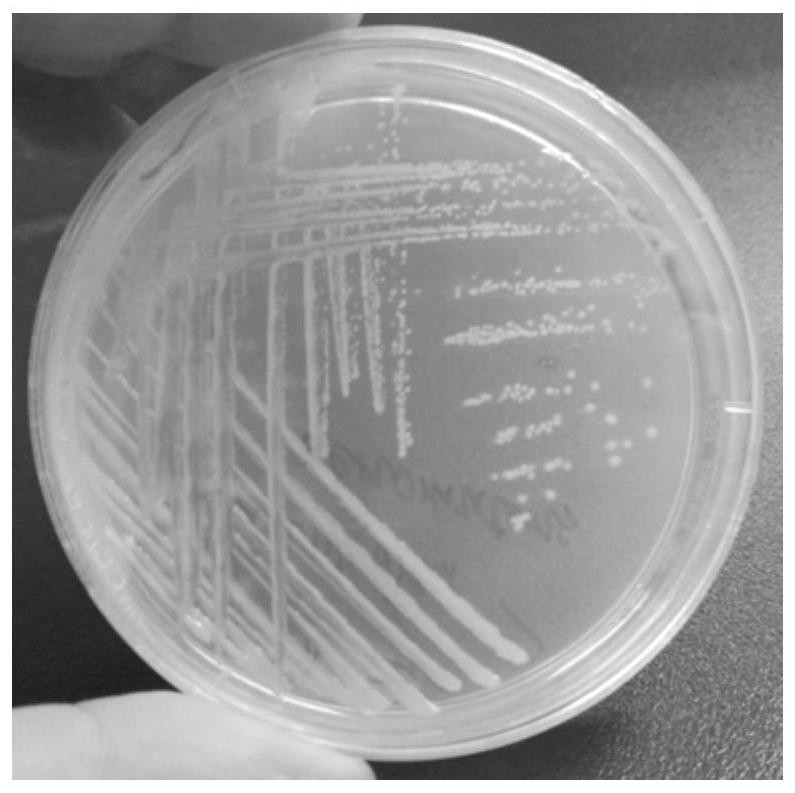A polycyclic aromatic hydrocarbon degrading bacterium and its screening method and application
A polycyclic aromatic hydrocarbon, degrading bacteria technology, applied in chemical instruments and methods, microorganism-based methods, biochemical equipment and methods, etc., can solve problems such as reducing the service function and value of marine ecosystems, sticking to polluted beaches, and lack of oxygen.
- Summary
- Abstract
- Description
- Claims
- Application Information
AI Technical Summary
Problems solved by technology
Method used
Image
Examples
Embodiment 1
[0026] Embodiment 1: strain morphological characteristics
[0027] Streak inoculate a single colony into HLB solid medium, place the plate upside down in a constant temperature incubator, and incubate at 28°C for 48 hours. The colony is round, yellow and opaque, with smooth and moist surface, regular edges, no halo, and a raised center. 2~3mm in diameter, see figure 1 .
Embodiment 2
[0028] Embodiment 2: Screening and identification of bacterial strains
[0029] (1) Pacific deep-sea sediments (sample number 45II-CC-S06-MC01, 4-6cm away from the surface layer of sediments, CC sea area of the second voyage of Oceania 45 voyage, 153°23.1205′W, 12°58.1135′N), The sediment is yellow-brown, odorless, weakly viscous, and the surface layer is semi-fluid, with a slightly silty feeling when rubbed by hand. After the sediment samples were aseptically collected, they were cryopreserved and then transported to the laboratory for the next stage of research.
[0030] Take the ocean surface seawater and sterilize it with high-pressure steam at 121°C for 20 minutes, then add 1% volume of sterile NH 4 NO 3 solution (100g / L) and KH 2 PO 4 solution (10g / L, pH6.7) and 0.1% volume of FeSO sterilized by a 0.22μm filter 4 (0.4g / L), the pH value of the medium obtained at last is about 7.5. Before inoculation, 1% (V / V) polycyclic aromatic hydrocarbons (carbon source concent...
Embodiment 3
[0032] Example 3: Determination of bacterial strain polycyclic aromatic hydrocarbons and alkane degradation ability
[0033] Take the ocean surface seawater and sterilize it with high-pressure steam at 121°C for 20 minutes, then add 1% volume of sterile NH 4 NO 3 solution (100g / L) and KH 2 PO 4 solution (10g / L, pH6.7) and 0.1% volume of FeSO sterilized by a 0.22μm filter 4 (0.4g / L), the pH value of the medium obtained at last is about 7.5. Add 1% (V / V) alkanes and polycyclic aromatic hydrocarbons (carbon source concentration is 50mg / L) before inoculation
[0034] After cultivating for five days, open the bottle mouth, obtain the mass spectrogram of the sample by GC-MS (gas chromatography-mass spectrometry), measure the residual amount of phenanthrene, and obtain a degradation rate of 50% to 60%. The residual amount of pyrene was measured, and the degradation rate was 60%-70%. The degradation rate of 16-alkane is 10%-20%, the degradation rate of 12-alkane is 15%-25%, and ...
PUM
| Property | Measurement | Unit |
|---|---|---|
| diameter | aaaaa | aaaaa |
Abstract
Description
Claims
Application Information
 Login to View More
Login to View More - Generate Ideas
- Intellectual Property
- Life Sciences
- Materials
- Tech Scout
- Unparalleled Data Quality
- Higher Quality Content
- 60% Fewer Hallucinations
Browse by: Latest US Patents, China's latest patents, Technical Efficacy Thesaurus, Application Domain, Technology Topic, Popular Technical Reports.
© 2025 PatSnap. All rights reserved.Legal|Privacy policy|Modern Slavery Act Transparency Statement|Sitemap|About US| Contact US: help@patsnap.com



